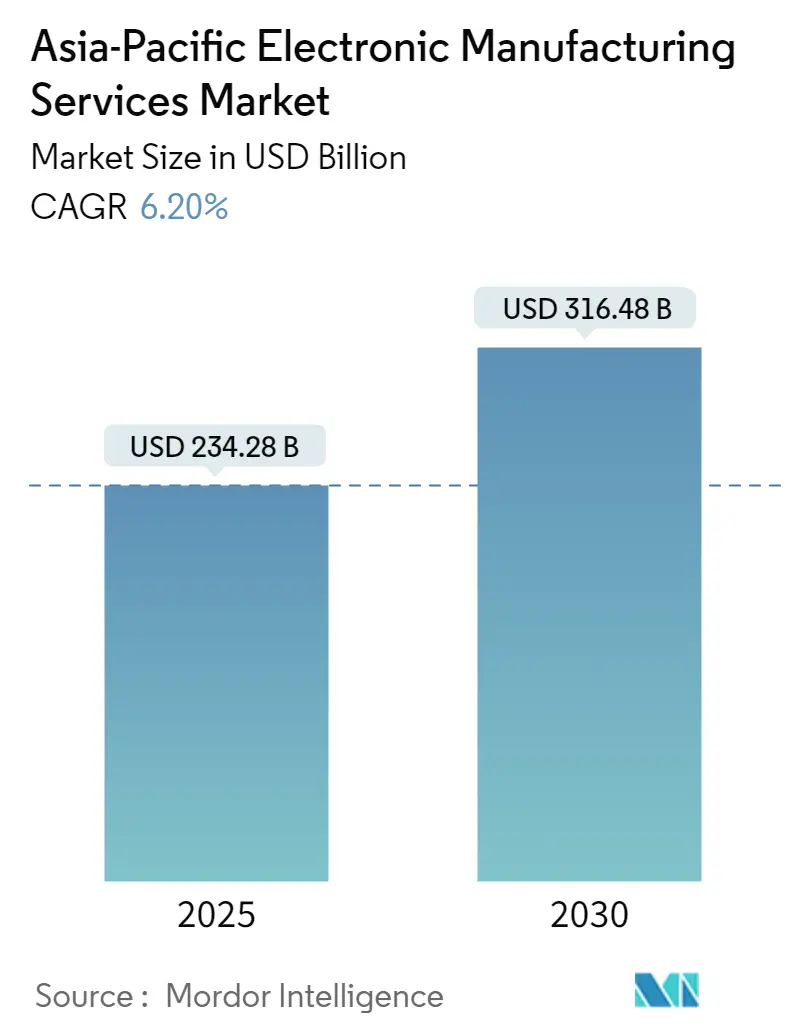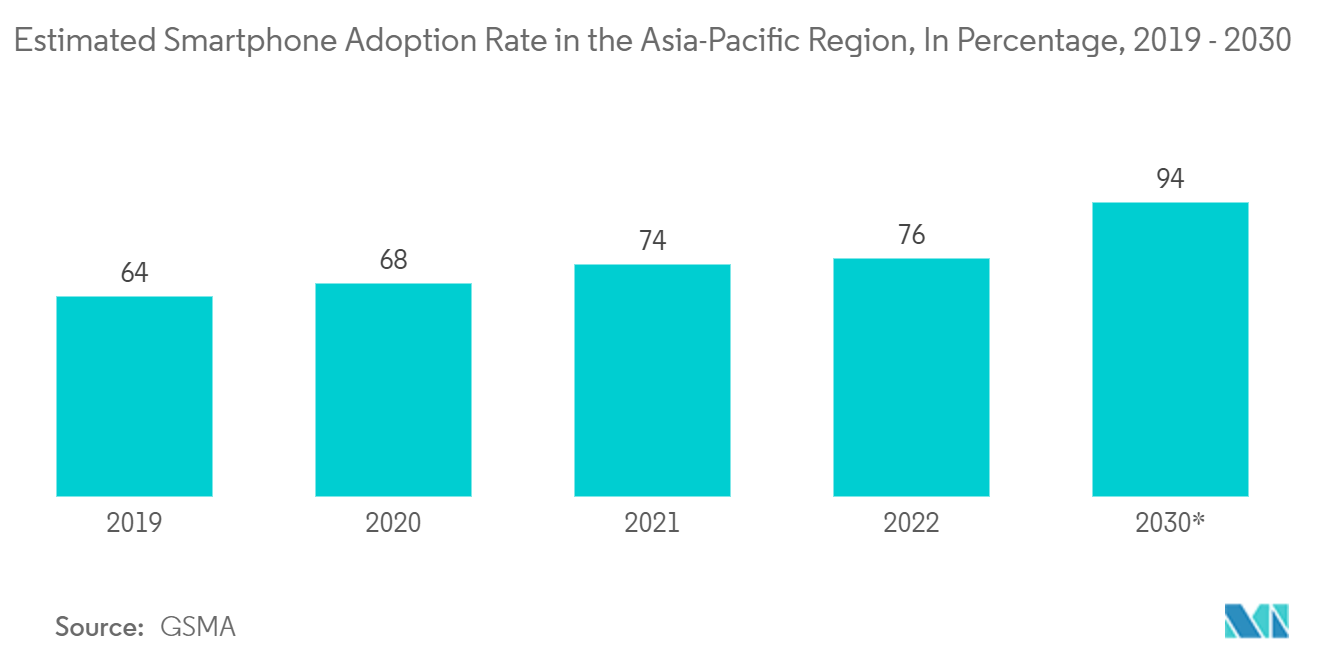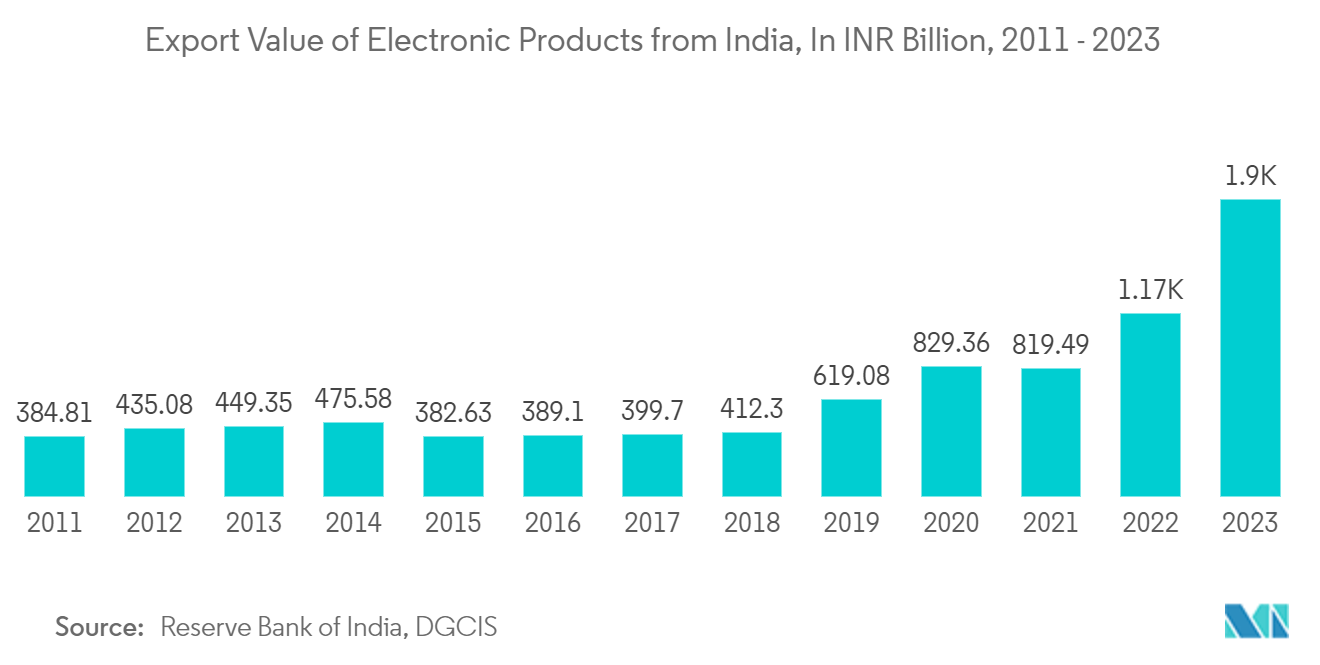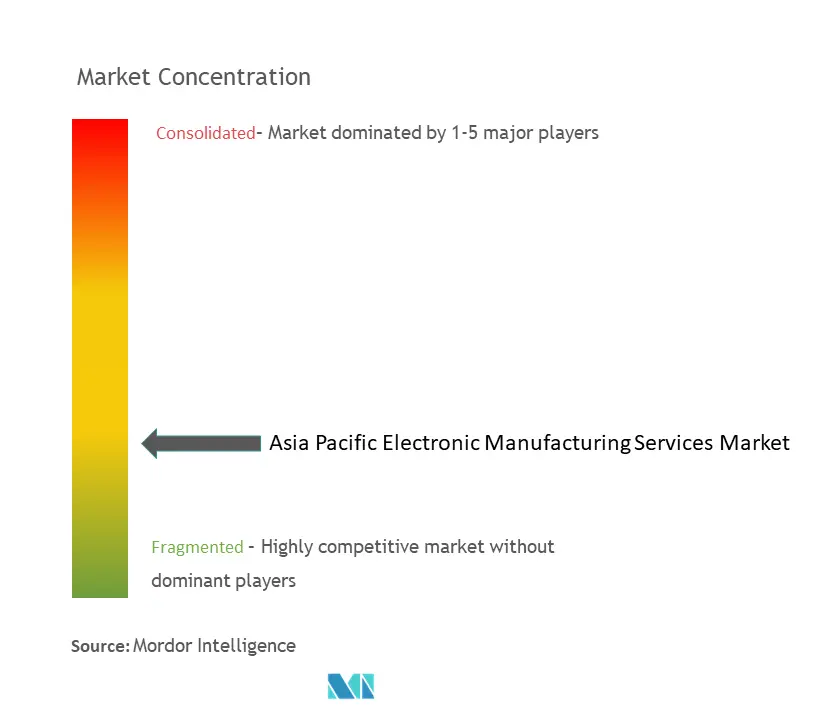Asia-Pacific Electronic Manufacturing Services Market Size and Share

Asia-Pacific Electronic Manufacturing Services Market Analysis by Mordor Intelligence
The Asia-Pacific Electronic Manufacturing Services Market size is estimated at USD 234.28 billion in 2025, and is expected to reach USD 316.48 billion by 2030, at a CAGR of 6.2% during the forecast period (2025-2030).
Several leading electronics brands worldwide are increasingly moving their manufacturing bases to countries in Asia-Pacific, notably China and India. They are drawn by the region's cost-effective labor, well-established supply chains, and supportive governmental policies. Consequently, this migration fuels a rising need for electronics manufacturing services (EMS) providers in Asia-Pacific. These providers are crucial in bolstering the production of consumer electronics and a wide array of electronic goods.
The trend toward miniaturization has catalyzed a surge in technological innovation. The rise of smaller, more potent components has been pivotal in enabling the Internet of Things (IoT). With these compact designs, devices housing these miniaturized components can shrink in size, enhancing functionality and user experience. Additionally, smaller components typically demand less energy, further bolstering their appeal. Consumer demand is shifting toward smaller, more portable electronic devices, including smartphones, wearables, and IoT gadgets. This trend challenges EMS providers to enhance their manufacturing processes and capabilities to accommodate these intricate electronic components and assemblies.
Further, the manufacturing sector is witnessing a surge in the adoption of IIoT technologies. These technologies empower automation, data-driven decision-making, and heightened operational efficiency. EMS providers are capitalizing on IIoT solutions in the region, including smart sensors, cloud-based analytics, and predictive maintenance. They refine their manufacturing processes, elevate product quality, and curb operational expenses. With IIoT at its core, EMS providers are stepping up to deliver advanced, integrated services, solidifying their stance as favored partners in the worldwide electronics supply chain.
Government initiatives across the region are propelling market growth. In August 2023, India's government passed new regulations requiring companies to secure licenses for importing various products, including laptops, tablets, personal computers, and servers. These regulations aim to enhance trust in imported hardware, reduce import dependence, and stimulate local manufacturing. By ramping up domestic electronics production, India is striving to enhance its technological self-sufficiency, secure critical supply chains, and further its objective of becoming a major electronics manufacturing hub.
However, one of the primary challenges impeding the growth of the Asia-Pacific market is the array of regulatory implications. Businesses in this region must adhere to a spectrum of environmental laws and regulations spanning local, state, federal, and even foreign domains. These regulations cover the manufacturing processes and extend to the storage, treatment, discharge, emission, and disposal of hazardous waste byproducts. Furthermore, lead dust can be a byproduct during the electronics assembly, necessitating companies to address it, even during facility vacating, potentially stalling market growth.
Moreover, Asia-Pacific comprises diverse nations with distinct regulatory frameworks, trade policies, and compliance mandates. EMS providers in this region grapple with comprehending and complying with these varied standards. These standards range from product safety and environmental regulations to data privacy laws, necessitating substantial investments in both time and resources.
Asia-Pacific Electronic Manufacturing Services Market Trends and Insights
The Consumer Electronics Application Segment is Expected to Witness Significant Growth
- The consumer electronics segment increasingly relies on electronics manufacturing services (EMS) to drive its expansion. As consumer electronics embrace advanced technology and features, the need for sophisticated manufacturing becomes paramount. Its focus on cost efficiency and adaptability underscores the industry's ability to meet consumer expectations effectively.
- EMS involves the engineering and design of printed circuit boards (PCBs), assembly, sub-assemblies, functional testing, and product and component design. These services cater to the demand for modern consumer devices. Also, EMS firms provide value-added engineering and manufacturing services to original equipment manufacturers (OEMs). This allows OEMs to boost operational efficiencies and focus on critical functions like R&D, aiding their adaptation to evolving market trends.
- In recent years, rapid urbanization and economic growth in countries such as China and India have driven the expansion of the middle class. This demographic surge has increased demand for consumer electronics, spanning smartphones, laptops, TVs, and home appliances. GSMA projected that smartphone adoption in the region would surpass 90% by 2030, underlining the region's tech appetite. Smartphones, in particular, are pivotal in driving revenue within the consumer electronics sector. As a result, EMS providers in the region are strategically positioned to cater to this growing consumer demand.
- Governments have implemented policies to bolster the electronics manufacturing sector in Asia-Pacific. These initiatives involve providing incentives and fostering the growth of electronics clusters and manufacturing hubs. For example, India's Production Linked Incentive (PLI) scheme offers a 4% to 6% incentive on the augmented sales of locally made goods, with a targeted focus on specific segments within the electronics industry. Such targeted strategies have significantly encouraged EMS providers to set up and scale their operations in the region.

India is Expected To Witness Significant Growth
- During the forecast period, India is poised to emerge as a dominant force in electronics manufacturing, propelled by a rising domestic appetite and enhanced export competitiveness. At the core of India's burgeoning electronics manufacturing landscape lies electronics manufacturing services (EMS).
- Recognizing the industry's potential, the Indian government has introduced several schemes to bolster electronics manufacturing. The Indian government has prioritized electronics hardware manufacturing as an essential pillar of the Digital India initiative. In addition, the Production Linked Incentive (PLI) scheme directly addresses India's high capital costs. In November 2023, the Production Linked Incentive (PLI) scheme attracted investments exceeding INR 1.03 lakh crore (~USD 12.3 billion).
- Technology adoption, rising affordability, and a push for sustainability are set to fuel the growth of domestic electronics production in the country. The advent of Industry 4.0 is notably amplifying this surge, with businesses embracing digital tools like AI, automation, and data analytics. These technologies are streamlining operations and maintaining efficiency and productivity.
- Alongside surging domestic demand, numerous international electronics manufacturers are relocating their outsourced manufacturing from countries like India to safeguard their supply chains. According to the Reserve Bank of India and DGCI&S, in fiscal year 2023, India's exports of electronic products surged, surpassing INR 1,899 billion (~USD 22.7 billion). This marked a substantial increase from the preceding year. This shift is bolstered by the Indian government's initiatives to lure foreign investments, mainly benefiting the Indian EMS market.

Competitive Landscape
The Asia-Pacific electronic manufacturing services market is highly competitive and has several players. Companies continuously try to increase their market presence by introducing new products, expanding their operations, or entering into strategic mergers and acquisitions, partnerships, and collaborations. Some significant players include Benchmark Electronics Inc., Flex Ltd, and Sanmina Corporation.
In April 2024, Zetwork, a manufacturing service provider, planned to enhance its production capabilities for various tech products. The company plans to invest approximately INR 1,000 crore (~USD 120 million) in enhancing its laptops, servers, smartphones, hearables, televisions, and telecom equipment facilities. Zetwork is positioning itself to rival established electronics manufacturing services providers in India and its key export market, the United States.
In February 2024, Taiwan Semiconductor Manufacturing Co., a prominent player in the semiconductor industry, inaugurated its inaugural chip manufacturing facility in Japan, marking a significant stride in its worldwide growth strategy. TSMC unveiled intentions for a second Japanese plant, slated to commence operations in approximately three years.
Asia-Pacific Electronic Manufacturing Services Industry Leaders
-
Benchmark Electronics Inc.
-
Hon Hai Precision Industry Co. Ltd (Foxconn)
-
Flex Ltd
-
Sanmina Corporation
-
Jabil Inc.
- *Disclaimer: Major Players sorted in no particular order

Recent Industry Developments
- February 2024: TSMC, Sony Semiconductor Solutions Corporation, DENSO Corporation, and Toyota Motor Corporation revealed plans for additional investments in Japan Advanced Semiconductor Manufacturing Inc. (JASM), a manufacturing subsidiary primarily owned by TSMC, located in Kumamoto Prefecture, Japan. This investment aims to establish a second fab, slated to commence operations by the close of 2027. Coupled with JASM's first fab, set to be operational in 2024, the collective investment in JASM is poised to surpass USD 20 billion, bolstered by significant backing from the Japanese government.
- February 2024: Tata Electronics and PSMC collaborated on a USD 11 billion investment to set up India's first 300 mm wafer fab in Gujarat. Additionally, they are establishing a USD 3 billion ATMP plant in Assam. PSMC will primarily manage the construction of the wafer fab, earning fees for both hardware and software. PSMC will maintain a hands-off stance concerning day-to-day operations and customer orders.
Asia-Pacific Electronic Manufacturing Services Market Report Scope
Electronics manufacturing services are used by organizations that design, manufacture, test, distribute, and provide return and repair services for electronic components and assemblies for original equipment manufacturers (OEMs). The study monitors revenue generated from services offered across multiple applications. It provides a detailed breakdown of market estimates based on service types, applications, and countries in Asia-Pacific.
The Asia-Pacific electronic manufacturing services market is segmented by service type (electronics design and engineering, electronics assembly, electronics manufacturing, and other service types), application (consumer electronics, automotive, industrial, aerospace and defense, healthcare, IT and telecom, and other applications), and country (China, Japan, India, and Rest of Asia-Pacific). The market sizes and forecasts are provided in terms of value (USD) for all the above segments.
| Electronics Design and Engineering |
| Electronics Assembly |
| Electronics Manufacturing |
| Other Service Types |
| Consumer Electronics |
| Automotive |
| Industrial |
| Aerospace and Defense |
| Healthcare |
| IT and Telecom |
| Other Applications |
| China |
| Japan |
| India |
| South Korea |
| Taiwan |
| Australia and New Zealand |
| By Service Type | Electronics Design and Engineering |
| Electronics Assembly | |
| Electronics Manufacturing | |
| Other Service Types | |
| By Application | Consumer Electronics |
| Automotive | |
| Industrial | |
| Aerospace and Defense | |
| Healthcare | |
| IT and Telecom | |
| Other Applications | |
| By Country*** | China |
| Japan | |
| India | |
| South Korea | |
| Taiwan | |
| Australia and New Zealand |
Key Questions Answered in the Report
How big is the Asia-Pacific Electronic Manufacturing Services Market?
The Asia-Pacific Electronic Manufacturing Services Market size is expected to reach USD 234.28 billion in 2025 and grow at a CAGR of 6.20% to reach USD 316.48 billion by 2030.
What is the current Asia-Pacific Electronic Manufacturing Services Market size?
In 2025, the Asia-Pacific Electronic Manufacturing Services Market size is expected to reach USD 234.28 billion.
Who are the key players in Asia-Pacific Electronic Manufacturing Services Market?
Benchmark Electronics Inc., Hon Hai Precision Industry Co. Ltd (Foxconn), Flex Ltd, Sanmina Corporation and Jabil Inc. are the major companies operating in the Asia-Pacific Electronic Manufacturing Services Market.
What years does this Asia-Pacific Electronic Manufacturing Services Market cover, and what was the market size in 2024?
In 2024, the Asia-Pacific Electronic Manufacturing Services Market size was estimated at USD 219.75 billion. The report covers the Asia-Pacific Electronic Manufacturing Services Market historical market size for years: 2019, 2020, 2021, 2022, 2023 and 2024. The report also forecasts the Asia-Pacific Electronic Manufacturing Services Market size for years: 2025, 2026, 2027, 2028, 2029 and 2030.
Page last updated on:
Asia-Pacific Electronic Manufacturing Services Market Report
Statistics for the 2025 Asia-Pacific Electronic Manufacturing Services market share, size and revenue growth rate, created by Mordor Intelligence™ Industry Reports. Asia-Pacific Electronic Manufacturing Services analysis includes a market forecast outlook for 2025 to 2030 and historical overview. Get a sample of this industry analysis as a free report PDF download.



